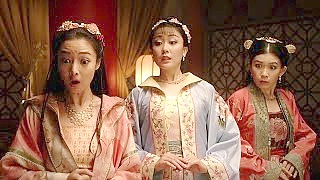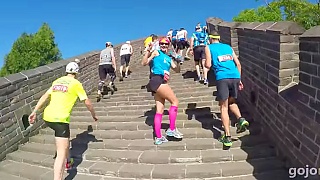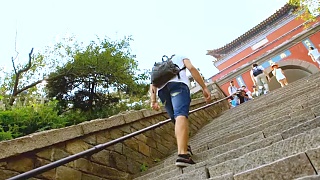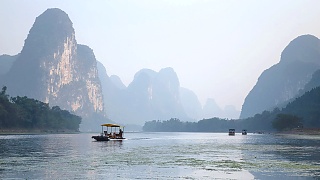
|
KunMing: 20 Kid-Friendly Places to Visit
Kunming Zoo (昆明动物园 Kūnmíng Dòngwùyuán): Zoo with a variety of animals, shows, and educational programs.
Dianchi Lake (滇池 Diānchí): Scenic lake with parks, boat rides, and recreational activities.
Yunnan Nationalities Village (云南民族村 Yúnnán Mínzú Cūn): Cultural theme park with ethnic minority exhibits, performances, and crafts.
Green Lake Park (翠湖 Cuìhú): Park with gardens, pavilions, and scenic views.
Yunnan Museum of Minority Nationalities (云南民族博物馆 Yúnnán Mínzú Bówùguǎn): Museum with exhibits on Yunnan's ethnic minorities, cultures, and traditions.
Yunnan Railway Museum (云南铁路博物馆 Yúnnán Tiělù Bówùguǎn): Museum with exhibits on Yunnan's railway history, technology, and artifacts.
Yuantong Temple (圆通寺 Yuántōng Sì): Buddhist temple with historic buildings, gardens, and statues.
Yunnan Wild Animal Park (云南野生动物园 Yúnnán Yěshēng Dòngwùyuán): Safari park with a variety of animals, shows, and interactive experiences.
Haigeng Park (海埂公园 Hǎigěng Gōngyuán): Park with lakes, gardens, and scenic spots.
Kunming Botanical Garden (昆明植物园 Kūnmíng Zhíwùyuán): Botanical garden with diverse plant collections, greenhouses, and walking trails.
Kunming World Horticulture Expo Garden (昆明世博园 Kūnmíng Shìbóyuán): Garden with themed areas, pavilions, and horticultural displays.
Western Hills Forest Reserve (西山森林公园 Xīshān Sēnlín Gōngyuán): Nature reserve with hiking trails, temples, and panoramic views of Kunming.
Kunming Grand View Park (昆明大观楼 Kūnmíng Dàguān Lóu): Park with traditional Chinese architecture, gardens, and viewpoints.
Yunnan Nationalities Museum (云南省民族博物馆 Yúnnán Shěng Mínzú Bówùguǎn): Museum with exhibits on Yunnan's ethnic minorities, history, and cultures.
Kunming Stone Forest Geological Park (昆明石林风景区 Kūnmíng Shílín Fēngjǐngqū): UNESCO World Heritage Site with unique limestone formations, caves, and trails.
Golden Temple Park (金殿公园 Jīndiàn Gōngyuán): Park with a Taoist temple, gardens, and scenic landscapes.
Yunnan Military Academy Museum (云南陆军讲武堂博物馆 Yúnnán Lùjūn Jiǎngwǔtáng Bówùguǎn): Museum with exhibits on Yunnan's military history, uniforms, and weapons.
Kunming Daguan Park (昆明大观公园 Kūnmíng Dàguān Gōngyuán): Park with lakes, pavilions, and traditional Chinese architecture.
Yunnan Nationalities University (云南民族大学 Yúnnán Mínzú Dàxué): University campus with architectural features, gardens, and cultural events.
Kunming Zoo (昆明动物园 Kūnmíng Dòngwùyuán): Zoo with a variety of animals, shows, and educational programs.
KunMing: 30 More Places to Visit
Yunnan Provincial Museum (云南省博物馆 Yúnnán Shěng Bówùguǎn): Museum with exhibits on Yunnan's history, culture, and artifacts.
Yuantong Mountain (圆通山 Yuántōng Shān): Scenic mountain with temples, pagodas, and hiking trails.
Kunming Golden Temple (昆明金殿 Kūnmíng Jīndiàn): Taoist temple with a golden pavilion, gardens, and cultural exhibits.
Yunnan Railway Museum (云南铁路博物馆 Yúnnán Tiělù Bówùguǎn): Museum with exhibits on Yunnan's railway history, technology, and artifacts.
Kunming Western Hills Forest Reserve (昆明西山森林公园 Kūnmíng Xīshān Sēnlín Gōngyuán): Nature reserve with temples, hiking trails, and panoramic views of Kunming.
Kunming Flowers and Birds Market (昆明花鸟市场 Kūnmíng Huāniǎo Shìchǎng): Market with flowers, birds, pets, and gardening supplies.
Green Lake Park (翠湖 Cuìhú): Park with gardens, pavilions, and scenic views.
Dianchi Lake (滇池 Diānchí): Scenic lake with parks, boat rides, and recreational activities.
Kunming World Horticulture Expo Garden (昆明世博园 Kūnmíng Shìbóyuán): Garden with themed areas, pavilions, and horticultural displays.
Stone Forest (石林 Shílín): UNESCO World Heritage Site with unique limestone formations, caves, and hiking trails.
Yunnan University (云南大学 Yúnnán Dàxué): University campus with historic buildings, gardens, and cultural events.
Kunming Dragon Gate (西山龙门 Xīshān Lóngmén): Taoist temple complex with sculptures, caves, and panoramic views.
Green Lake Park (翠湖 Cuìhú): Park with gardens, pavilions, and scenic views.
Kunming Cuihu Park (昆明翠湖公园 Kūnmíng Cuìhú Gōngyuán): Park with a lake, pavilions, and walking paths.
Kunming Confucius Temple (昆明文庙 Kūnmíng Wénmiào): Confucian temple with historic architecture, gardens, and cultural events.
Yuantong Temple (圆通寺 Yuántōng Sì): Buddhist temple with historic buildings, gardens, and statues.
Kunming Grand View Park (昆明大观楼 Kūnmíng Dàguān Lóu): Park with traditional Chinese architecture, gardens, and viewpoints.
Kunming Flowers and Birds Market (昆明花鸟市场 Kūnmíng Huāniǎo Shìchǎng): Market with flowers, birds, pets, and gardening supplies.
Yunnan Museum (云南省博物馆 Yúnnán Shěng Bówùguǎn): Museum with exhibits on Yunnan's history, culture, and artifacts.
Kunming Western Hills Forest Reserve (昆明西山森林公园 Kūnmíng Xīshān Sēnlín Gōngyuán): Nature reserve with temples, hiking trails, and panoramic views of Kunming.
Kunming Dragon Gate (西山龙门 Xīshān Lóngmén): Taoist temple complex with sculptures, caves, and panoramic views.
Green Lake Park (翠湖 Cuìhú): Park with gardens, pavilions, and scenic views.
Dianchi Lake (滇池 Diānchí): Scenic lake with parks, boat rides, and recreational activities.
Yunnan Nationalities Village (云南民族村 Yúnnán Mínzú Cūn): Cultural theme park with ethnic minority exhibits, performances, and crafts.
Yunnan Provincial Museum (云南省博物馆 Yúnnán Shěng Bówùguǎn): Museum with exhibits on Yunnan's history, culture, and artifacts.
Kunming Golden Temple (昆明金殿 Kūnmíng Jīndiàn): Taoist temple with a golden pavilion, gardens, and cultural exhibits.
Yunnan Nationalities University (云南民族大学 Yúnnán Mínzú Dàxué): University campus with architectural features, gardens, and cultural events.
Kunming Cuihu Park (昆明翠湖公园 Kūnmíng Cuìhú Gōngyuán): Park with a lake, pavilions, and walking paths.
Kunming Confucius Temple (昆明文庙 Kūnmíng Wénmiào): Confucian temple with historic architecture, gardens, and cultural events.
Stone Forest (石林 Shílín): UNESCO World Heritage Site with unique limestone formations, caves, and hiking trails.
|




 Planning war on China – the West is ramping up
Planning war on China – the West is ramping up







![Quote (from the BBC `news` website, 19th February 2023) : `Meanwhile, friends of the detainees [supposedly lockdown protesters], anxious and worried for their own personal safety, continue to keep tabs on the situation and share information. Many of them live overseas and did not attend the November protests . . . [about saving lives with lockdowns]. ` The lockdowns might have been over the top, but doubtless saved many lives - so that is a matter of debate; and the `protesters` might have had some good arguments [one might say], but the key thing here is whether in reality it was all a Western attempt at subverting China; and if one looks at other articles around the same time / leading up to these `protests` [greatly exaggerated], that seems to indeed be the case. Again, in the BBC`s own words : Many of them LIVE OVERSEAS. In the BBC`s own words : Many of them LIVE OVERSEAS. LIVE OVERSEAS. This is a very important point to keep in mind : these people were not there, but somehow have something to say, and their `not even there` tale is being pushed by MSM. It is the XinJiang / HK scam repeated over, and over, and over again. Who are these people and who do they work for ? [Well hidden of course] Not knowing these facts, why trust them ??? Enough of the BBC - they have no credibility; we are not going to do this every day [when see excrement, step over it, it is not worth analysing]; the lies are easy to spot, if you look. Open your eyes . . . And always remember that propaganda is the first move in war - demonise your `enemy` [everyone `else`]. While frustration can be understood, covert agendas [and foreign recruits?] are another thing. For sure, though, the `daily hate` will continue; and shame on them. *** Once the venom is extracted, the disease is cured. *** Bonus film - the US spent millions of dollars shooting down $12 hobby balloons . . . A thought on the latest BBC's daily China hate article](https://img.youtube.com/vi/1EFiAy8THFA/mqdefault.jpg)






![Planning War On China part 40 (the encore). From now, all similar content will be on the new Geopolitics page, so do check that out and bookmark. Something Different, health, and psychology videos are likely to also move to their own pages. So we will still cover all these aspects of life, but have more time to focus on Chinese culture and China travel. *************************** Official racism is a very important fact to consider, and because it is is based on propaganda, can be easily missed for what it really is. Yet once seen, it is all so clear. Us and Them - is the sales pitch of supremacists and bomb companies. That is ALL it is. There is no `us and them`; that is just a scam to fool you into obedience / subservience / enslavement. The real schism is that there are real / open-eyed people, and then there are the brainwashed / believers people. Simple as that. Puppets at the top; puppets at the bottom. One life, one world, one family. One has love, or one does not. Real love doesn`t have targets; real love is a light that shines in all directions. Onto the video film . . . With George Galloway in conversation with Jerry`s Take on China . . . Bonus films . . . George at his very best - don`t miss it . . . What is more important - life or money (power) ? Simply believe ? Or be free to see reality ?? No longer puppet. Live more . . . Because it is not about `me` (that is the scam / fantasy, and a big topic in itself - `your problems are all your fault`, is part of it); it is really about `WE`. In China, the people are family. In the West, the people are livestock. And that is the `threat`. [ video v=fIxPv2Dn_P0 ] Oliver Stone interviews Vladimir Putin . . . Taiwan the next Ukraine ? . . . Lee Camp . . . [ video v=OSkpIq3T-Zc ] Racism is racism is racism. There is NO excuse, no matter how `official` it is sold to you. Something like 3 million died in the Vietnam war (not including the carpet bombing of Laos and Cambodia), alone. This is what racism entails. How many times will this lie play out ? Meanwhile . . . Peace. Official racism. Reality is so very different from the 'official' / MSM narrative / fairy tale - DON'T MISS THIS !](https://img.youtube.com/vi/Kc7f4JKhwtk/mqdefault.jpg)

















